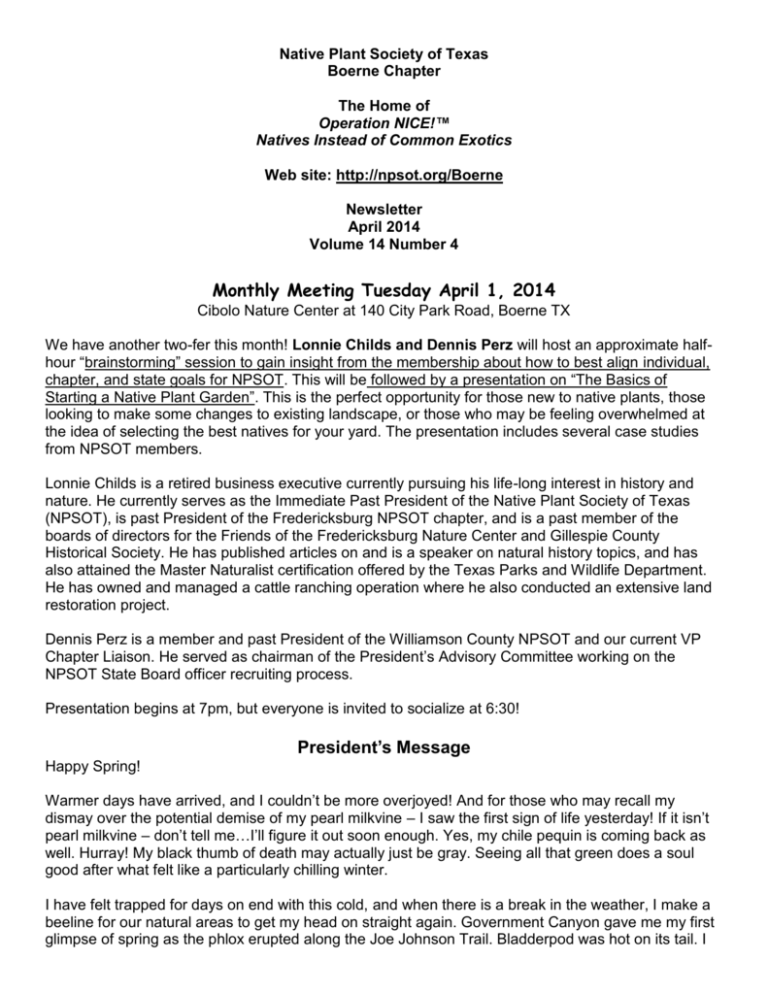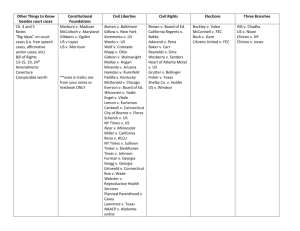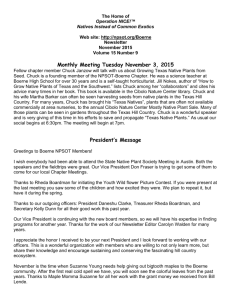Bob Bockholt, GRI - Native Plant Society of Texas
advertisement

Native Plant Society of Texas Boerne Chapter The Home of Operation NICE!™ Natives Instead of Common Exotics Web site: http://npsot.org/Boerne Newsletter April 2014 Volume 14 Number 4 Monthly Meeting Tuesday April 1, 2014 Cibolo Nature Center at 140 City Park Road, Boerne TX We have another two-fer this month! Lonnie Childs and Dennis Perz will host an approximate halfhour “brainstorming” session to gain insight from the membership about how to best align individual, chapter, and state goals for NPSOT. This will be followed by a presentation on “The Basics of Starting a Native Plant Garden”. This is the perfect opportunity for those new to native plants, those looking to make some changes to existing landscape, or those who may be feeling overwhelmed at the idea of selecting the best natives for your yard. The presentation includes several case studies from NPSOT members. Lonnie Childs is a retired business executive currently pursuing his life-long interest in history and nature. He currently serves as the Immediate Past President of the Native Plant Society of Texas (NPSOT), is past President of the Fredericksburg NPSOT chapter, and is a past member of the boards of directors for the Friends of the Fredericksburg Nature Center and Gillespie County Historical Society. He has published articles on and is a speaker on natural history topics, and has also attained the Master Naturalist certification offered by the Texas Parks and Wildlife Department. He has owned and managed a cattle ranching operation where he also conducted an extensive land restoration project. Dennis Perz is a member and past President of the Williamson County NPSOT and our current VP Chapter Liaison. He served as chairman of the President’s Advisory Committee working on the NPSOT State Board officer recruiting process. Presentation begins at 7pm, but everyone is invited to socialize at 6:30! President’s Message Happy Spring! Warmer days have arrived, and I couldn’t be more overjoyed! And for those who may recall my dismay over the potential demise of my pearl milkvine – I saw the first sign of life yesterday! If it isn’t pearl milkvine – don’t tell me…I’ll figure it out soon enough. Yes, my chile pequin is coming back as well. Hurray! My black thumb of death may actually just be gray. Seeing all that green does a soul good after what felt like a particularly chilling winter. I have felt trapped for days on end with this cold, and when there is a break in the weather, I make a beeline for our natural areas to get my head on straight again. Government Canyon gave me my first glimpse of spring as the phlox erupted along the Joe Johnson Trail. Bladderpod was hot on its tail. I also encountered my first bluebonnet of the year. A terribly small little thing, all alone, on the Far Reaches trail. A quick trip to Lost Maples and a hike along the West trail revealed one of my favorite trees, a Texas madrone, right there in plain-view! My surprise came from the fact I have hiked the trail numerous times and never noticed this beauty! To be fair, the tree does sit at the top of a rather long and rough incline, and it is very likely that I have been so focused on just making it up the hill that I never bothered to look up and see it! And lastly, I took a peek over the cliff edge above the river at Guadalupe River State Park and the red columbine is coming along nicely! No sign of flowers as of last week, but I will be checking back frequently. The image is from March 25, 2012 and I make it a point to visit at about the same time to see how the columbine is doing. I do the same for a purple leatherflower at Enchanted Rock. It is amazing to see how resilient our natives are. I definitely saw an impact to the leatherflower in 2011, but I was greeted on visits out to “The Rock” in April and May 2012 with a wonderfully diverse show of wildflowers. I also met stinging nettle for the first time, but that is another story… I hope everyone enjoyed our March presentation about the Albert and Bessie Kronkosky State Natural Area! James Rice is quite the firecracker, and I am pretty sure I saw, at least a few of our members, chomping at the bit to get out there and investigate this local treasure. With any luck, we will be able to schedule a field trip to get a glimpse ourselves. The volunteer opportunities seem extensive! The ForWard Trail project is moving along wonderfully under the ever-watchful and deeply committed eye of Suzanne Young and her team! Yes, it will be a long process, but talk about a worthy outcome. These creative minds have quite a vision for the trail and it will be beautiful. If you haven’t visited our chapter website in a while, I have added a few resources you may find interesting – a list of native nurseries along with links to their websites, an ever-growing list of recommended books, and a handful of links to interesting websites and videos suggested by our members and speakers. You are welcome, and I would encourage you, to forward me anything you feel would be helpful to people visiting our website. You may be surprised to know that we get, on average, 50 – 100 “hits” on a daily basis. People really do use it quite often to read Native Grown, and check out our NICE! recommendations. So the more useful content, the better! We cannot forget the rapidly approaching MOSTLY NATIVE PLANT SALE! If you haven’t signed up to help out at our booth, please contact Betty Dunn (bebsd@hotmail.com) ASAP! Our members have an amazing assortment of knowledge and personal experience with natives and this is the perfect setting to share that knowledge with people looking to incorporate native plants into their yards. It is a really fun and rewarding day, and I hope to see a great crowd out there! Lastly, I know a big group of members is headed out to party it up at Rancho Lomitas the weekend of April 12th. I wish you all safe travels and perfect weather. Remember, what happens in Rancho Lomitas, stays in Rancho Lomitas. Except for an article for the newsletter. I’m looking at you, Wilt! Thanks so much! Emily Chapter Activities Operation Nice! NICE! ™Plant of the Month April 2014 Woolly Butterflybush Buddleja marrubiifolia by Anne Adams Woolly Butterflybush is a medium-sized, drought-resistant shrub that provides attractive foliage as well as colorful flowers throughout summer and into fall. In its native range of the Chihuahuan Desert, it grows on well-drained sunny sites in desert canyons and arroyos. Leaves are deciduous to almost evergreen, and in my yard plants retained some leaves all winter in spite of several nights below 20 degrees. However, it may need protection in very cold winters as it is considered hardy only down to 15 degrees. A cultivar called “Presidio” is said to be relatively cold-hardy. Growing to a height of 3 to 6 feet and a similar width, Woolly butterflybush maintains its naturally dense form with little pruning. Fine woolly hairs on stems and leaves give the plant a soft gray-green color and velvety feel. The aromatic leaves are small and oval with serrate margins. These characteristics are responsible for the plant’s species name, for its resemblance to Marrubium vulgare, commonly known as horehound. During summer through late fall, Woolly butterflybush puts on a display of ½ inch round heads of small, bright yellow to orange flowers, which contrast nicely with the foliage, and attract butterflies as well as other nectar-feeding insects. Light pruning may be done during winter to early spring to maintain a natural shape and promote flowering. Used in a landscape, this shrub will add variety and texture as well as color to the design. Since both white-tailed and axis deer roam freely through my neighborhood, I protect all new tree and shrub plantings with wire cages. Although Woolly butterflybush is not a preferred browse species and I have not seen any nipping of leaves or twigs that extend beyond the cages, others have reported damage. Operation NICE! Tip: Many cultivars and hybrids of Buddleja that are popular in the nursery trade were brought here from China, South Africa, or other parts of the Americas. While their colorful flower spikes are attractive to butterflies, some are known to be invasive. Start planning for planting in 2014. The 2014 NICE! poster and planting instructions for all of our NICE! plants are on our website: http://npsot.org/wp/boerne/ CNC Demo Gardens It was a mild but misty morning when six of us, Rita Boardman, Anne Adams, Wilt Shaw and Emily Werner and her ever helpful husband, met at CNC to work on the gardens. We managed to plant two new shrubs, a Tickle-Tongue (Zanthoxylum hirsutum, also known as Texas Prickly Ash) and Rusty Blackhaw Virbunum (Viburnum rufidulum), and trim back winter killed or leggy growth on all butterfly gardens. We were dripping by the time we finished, but the gardens did look a lot better. With only six people we could not weed the beds within our timeframe so will have to schedule another workday for that much needed chore. Hope better weather will prevail for that upcoming day. Mostly Native Plant Sale Our biggest fund raising and fun event is on the near horizon - April 4 (CNC presale) and 5 (open to public) at theKendall County fairgrounds pavillion! It's been a cold and overcast winter so many of our plants look a bit behind what we usually expect, but we will have a great day anyway. Please bring plants and come out to help on Friday and/or Saturday. We will need many pairs of hands to make this happen. It's always a fun time visiting with each other during these days, and I know that many look forward to it. As usual, deliver plants and park in the back parking area accessed off the CNC entry drive (City Park Rd). We will begin set-up at noon on Friday with the CNC presale occurring between 5-7 pm. Friday is hectic and we really need a lot of help this day! On Saturday the sale, open to the public, begins at 8:30 AM and ends at 3 PM when we break down our display. We encourage you to pick up any leftover plant you donated as there will be limited or no care for these plants later. Let the entry guards know that you are volunteering at the sale so you won't have to pay for parking. Hope to see you there! Betty Dunn Regional Science Fair Kathy Ward and Bill Woller, helped judge posters for the regional science fair held at the University of Incarnate Word on March 3. The San Antonio and Boerne NPSOT chapters jointly awarded $100 certificates to two of the winners in the Environmental Sciences category. Varsha Mulamreddy from Keystone School in San Antonio was the Junior Division winner in the Environmental Sciences Category, 6th grade for her project titled: Biodegradation of Ammonium Nitrate using Limnobium spongia and Azolla caroliniana. Varsha also won 5th prize in Environmental Sciences for the Junior Division. Layne Garza who attends James Madison High School in San Antonio was the Senior Division Environmental Sciences winner for his project Phase 2 Killer Mulch: A study comparing tannin levels in Juniperus ashei and its effects on seed germination and seed development. It is encouraging to see these young people interested in and doing good research related to plants and their importance in the health of the environment. Regional Stuff The Hill Country Chapter of the Texas Master Naturalists April 28, 2014 Native Bees of Texas Michael Warriner, Program Supervisor of Texas Parks and Wildlife Department’s Nongame and Rare Species Program will talk on Texas Native Bees at the Hill Country Texas Master Naturalists Chapter Meeting. Native bees are critical to native plant reproduction and are key players in the maintenance of Texas’s natural ecosystems. A significant number of native plants pollinated by these bees produce fruit, nuts, or seeds that thousands of animal species depend upon for food, including some popular game animals. Native bees also play economically important roles in agricultural production. The value of native bees to U.S. agriculture is estimated to be approximately $3 billion annually. In 2009 Michael moved to Texas to become resident invertebrate biologist for TPWL. He curates the website www.texasbumblebees.org since bumblebees are the most easily recognized native bees. His goal was to enlist “bumble-watchers” in evaluating the state’s bumblebee fauna; the last published survey was in 1913. Prior to Texas, as the invertebrate zoologist for the Arkansas Natural Heritage Commission, he conducted surveys of bumblebees occurring in Arkansas remnant grasslands for 6 years and involved citizen scientists in the process. Michael received his bachelor’s degree at University of Arkansas at Little Rock and his master’s Degree at Emporia State University in Topeka, Kansas. In addition, as a research associate he worked on forest entomology at Mississippi State University. His publications include a large diversity of interesting insects. The monthly meeting of the Master Naturalist is free and open to the public. Meetings are held at the Upper Guadalupe River Authority’s lecture hall, located at 124 Lehmann Dr. in Kerrville. Socializing begins at 6:30pm, with the program starting at 7:00. For questions regarding this presentation, please contact our program coordinator, Kathy Ward at kathyollu@aol.com. News from the Balcones Satellite of the Texas Invaders Arrest the Arundo...Cutting Giant Reed Down to Size Are you looking for volunteer opportunities? During the month of April, Balcones Satellite volunteers will continue to tackle a very large stand of Giant reed (Arundo donax) as part of our ongoing efforts to restore the Leon Creek Greenway. Giant reed is a tall, perennial grass that can grow to over 20 feet in height. It is one of the most prevalent and pervasive invasive plants in Texas. It forms impenetrable thickets for hundreds of miles along the Rio Grande, may be seen in nearly every ditch, stream and riverbank along Highway 90 east of San Antonio, and is cropping up in too many new locations to count. Why is Giant reed a problem? It chokes riversides and stream channels, crowds out native plants, interferes with flood control, increases fire potential, and reduces habitat for wildlife. It forms a framework for debris dams behind bridges, culverts, and other structures that lead to damage. It alters natural creek and river channels. It ignites easily and can create intense fires. Because the plant contains many chemicals toxic to insects and invertebrates, not many herbivores browse it. Originally from the Mediterranean, Giant reed has become widely dispersed into all of the subtropical and warm temperate areas of the world, mostly through intentional human introductions. Its fleshy, creeping rootstocks form compact masses. Lonnie Shockley likes to show volunteers a Giant reed root that is several feet long and looks like a giant piece of ginger root! Any portion of the rhizome that breaks off can float miles downstream, take root and initiate new infestations. Once established, Giant reed has the ability to outcompete and completely suppress native vegetation In San Antonio, local volunteers are needed for eradication of Giant reed. No prior experience is required. Wear sturdy shoes, long-sleeved pants and shirts and gloves. Bring water. We have a supply of loppers, but welcome anyone who brings their own. For details of exact location and directions, contact Lonnie at lonnieshockley@satx.rr.com. Those on the mailing list will receive notification of the location of the Giant reed infestation and cancellation for severe weather conditions. The April schedule is Tuesdays 8:30 to 10:30 am on the Leon Creek Greenway Happenings – the Calendar April 1 (Tuesday) 7:00 PM. Monthly meeting, Lonnie Childs and Dennis Perz from the NPSOT State office will seek input from members about how the State can help the chapter and will present 3 case studies on how to create a natives garden from scratch. April 4 &5 (Friday evening 5-7 CNC presale & Saturday 8:30 AM 3:00 PM) Mostly Native Plant Sale at Kendall County Fair Grounds. If you can help with any aspect of the event and have not signed up, contact Betty Dunn at bebsd@hotmail.com April 26 (Saturday). Native Plant Spring Symposium, sponsored by Native Plant Society of Texas and the Lady Bird Johnson Wildflower Center, at the Center and at which Doug Tallamy will be the keynote speaker. More information and registration are available at http://www.wildflower.org/springsymposium/ . May 6 (Tuesday) 7:00 PM. Monthly meeting, Award-winning photographer David Langford will talk with us about water policy in Texas and sign his books. To find out about activities and workshops with other organizations call or visit their websites: Cibolo Nature Center (830.249.4616) http://www.cibolo.org/calendar Master Naturalist: San Antonio, Alamo Chapter http://txmn.org/alamo/ Kerrville, Hill Country Chapter http://txmn.org/hillcountry/ Friends of Friedrich Wilderness Park (210.372.9124) Medina River Natural Area Second Saturday Programs (210.624.2575) For more information or to RSVP for any event please contact by telephone. Website: www.sanaturalareas.org Our meetings are free and open to the public. Join us the first Tuesday of the month, January-June and SeptemberDecember, at 6:30 p.m. at the Cibolo Nature Center, Boerne, Texas. Our Sponsors Please support the following businesses that sponsor our newsletter HILL COUNTRY AFRICAN VIOLETS & NURSERY 32005 IH 10W Boerne, TX 830-249-2614 BERGMANN LUMBER CO. 236 S. Main Boerne, TX 830-249-2712 830-816-2193 MEDINA GARDEN NURSERY Growing Native Plants Since 1999 3417 State Hwy 16-N, Medina, TX 78055 (830) 589-2771 STONE & SOIL DEPOT INC. 26923 IH 10 West Boerne, TX 210.687.1005 http://medinagardennursery.com/ Become a Sponsor! A LITTLE NATURE STORE 106 E. Theissen St. Boerne, TX 830-249-2281 REMAX ASSOCIATES-BOERNE Bob Bockholt, GRI 309 Water Street, Boerne, TX 830-816-2660 Become a Sponsor!







